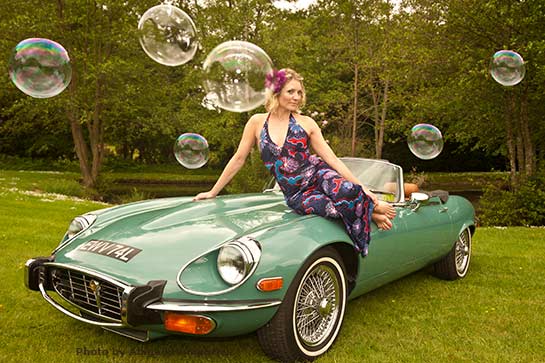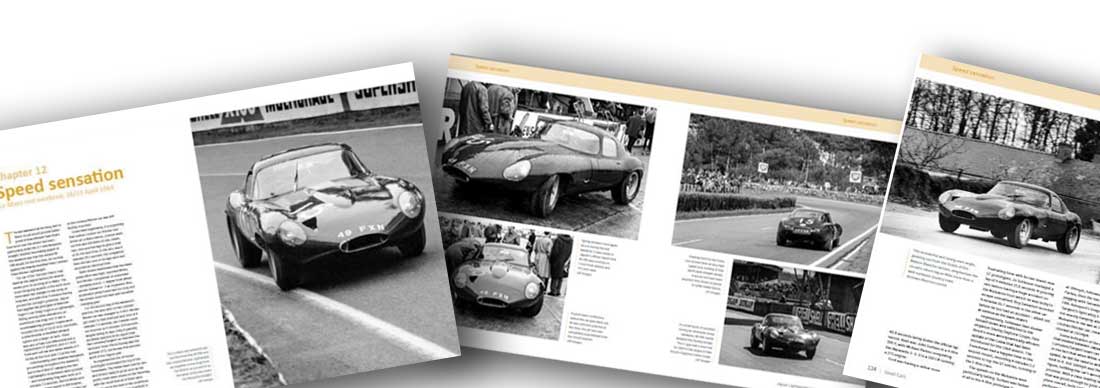E-type – The Fashion Icon

All images by Abigail Humphries
The E-type went on sale in 1961 and remained in production until 1974, bridging two decades that would come to define the fashion industry. Both the fashion of the ’60s and ’70s and the E-type today evoke nostalgia, and share an important place in British culture. Here, Philip Porter reflects on a classic era for design, and with the help of Abigail Humphries reconnects the E-type with the fashion of its period.
Sixties Fashion
The ’60s was the decade when inhibition died. The young broke free from the stereotypes of their parents and through fashion and music expressed themselves in new and outrageous ways, flouting convention. London led the way with Mary Quant in Chelsea, Biba in Kensington and Carnaby Street in Soho.
Mary Quant opened a boutique, Bazaar, in the King's Road as early as 1955. Uniquely, she designed for young people and used strong colours in a grey age, keeping her prices affordable. ‘Snobbery has gone out of fashion,’ Quant was quoted as saying, ‘and in our shops you will find duchesses jostling with typists to buy the same dresses.’
With its low rents, other boutiques sprang up in the King’s Road. With their outlandish designs and surreal window displays, art students, film directors and socialites were drawn to these magnets creating the ‘Chelsea Set’. It was said that on a Saturday afternoon, the Rolling Stones and the new pop aristocracy would mix with the crowds in the King’s Road, and shoppers emerged transformed, as suede-clad American Indians or romantic heroines in satin and lace. It was the age of velvet and brave colours.
Although Mary Quant’s trademark became the mini-skirt, and she may well have been the first to invent this absolute icon of the Swinging Sixties, Barbara Hulanicki, who created the fabulous Biba shops, claimed to have popularised them. It came about in an amusing way. Shortly after moving to her second shop, in Kensington Church Street in 1966, one of her employees received a delivery of stretchy jersey fabric steaming hot from the finishers. Instead of letting it rest, which allows the material to return to its proper width, he immediately cut it for some suits. ‘When I saw the delivery, I nearly had a heart attack,’ she wrote in her autobiography. ‘The skirts were only 10 inches long. “God,” I thought, “we'll go bust – we’ll never be able to sell them.” I couldn’t sleep, but that little fluted skirt walked out on customers as fast as we could get it onto the hatstands.’
Biba customers included Twiggy (‘the face of the ’60s’), Brigitte Bardot, Ready, Steady Go presenter Cathy McGowan, Julie Christie, Samantha Eggar, Cilla Black, Mia Farrow, Barbra Streisand, Marianne Faithful and many more.
Carnaby Street became famous for its shops such as John Stephen and I Was Lord Kitchener’s Valet. Employing the skills of the established Soho ‘rag trade’, it consisted of a small concentrated mass of eclectic shops selling cheap, fashion-driven clothing and became another symbol of the new free spirit and expression.
This was the age of dolly birds, and the mods (short for modernists) were the modern dandies. And the coolest car to be seen in was undoubtedly an E-type Jaguar.
E-types frequently prowled up the King's Road.
Seventies Fashion
Fashion in the ’70s continued many of the ’60s themes, including the mini-skirt, but developed with softer lines, influenced by the ‘Flower Power’ culture imported from San Francisco and by the hippy movement of the late ’60s.

Alternatives to the mini became popular with midi (mid-calf length) and maxi (full length) skirts. Ultra-short shorts, known as hot pants, also entered the scene. Trousers became flared and even more flared as the decade wore on. Denim, which had been tipped to become popular in March 1961 when the E-type was launched, really blossomed in the ’70s. Platform soles combined with the flares to be the distinctive, iconic look of ’70s fashion.
Biba acquired the old Derry & Toms department store in Ken High Street in 1973 and re-invented art deco. To anyone who visited this shrine to ’70s fashion, it left a lasting impression with its black walls, piles of affordable, exciting fashions and fabulous style. Biba embraced nostalgia and Laura Ashley, from her first, very small, cluttered shop in the shadow of the Michelin building in Fulham Road, popularised the Edwardian look.
In many ways, the ’70s fashions became more sophisticated, just as the E-type had developed.

The Models
Rebecca Reaney and Saskia Lockey are both actresses who have performed in many productions on the West End stage. Rebecca has many film and TV credits to her name. Saskia trained at the Royal Ballet School and has worked extensively in television.

The Photographer
Abigail Humphries is a professional photographer and has a 1st Class BA Honours degree in the subject. She was taught by some of the biggest names in British contemporary photography including Oded Shimshon, John Gotto and the legendary John Blakemore.
Abi joined Porter Press in 2006 and plays a key role as Design & Media Manager.
Shoot Producer
Julie Porter trained for the theatre at Drama Studio, London, and for teaching earned her licentiate at both LAMDA and Guildhall. Julie has coached several West End actors including the stars of this shoot. She has extensive acting credits in theatre and film. In 2013 she directed and played Olivia in Twelfth Night for the Royal Shakespeare Company Openstages programme. She is also a voiceover artist.

The Cars Provided by Eagle
Since Henry Pearman formed Eagle in 1982, the company has been dedicated to the bespoke restoration and engineering of a single, exceptional car – the E-type Jaguar.
In recent years, they have created the Eagle Speedster, Spyder GT and the Lightweight GT, stunning E-type-based designs which have set incredibly high standards of design and engineering.






Original Period Costumes
The best, hand-picked vintage clothing
Peekaboo Vintage online will be re-launching in Spring/Summer 2021, contact: info@peekaboovintage.com
Also, 'The Archive Vintage', available here https://marketplace.asos.com/boutique/the-archive-vintage






Leave a comment
This site is protected by hCaptcha and the hCaptcha Privacy Policy and Terms of Service apply.